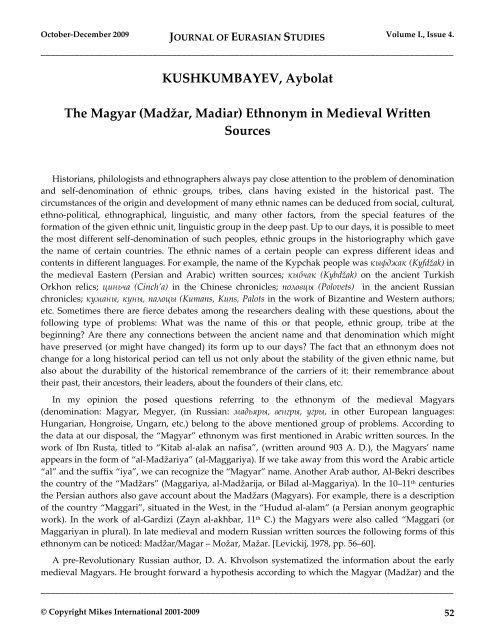JOURNAL OF EURASIAN STUDIES
JOURNAL OF EURASIAN STUDIES
JOURNAL OF EURASIAN STUDIES
Create successful ePaper yourself
Turn your PDF publications into a flip-book with our unique Google optimized e-Paper software.
October-December 2009 <strong>JOURNAL</strong> <strong>OF</strong> <strong>EURASIAN</strong> <strong>STUDIES</strong> Volume I., Issue 4.<br />
_____________________________________________________________________________________<br />
KUSHKUMBAYEV, Aybolat<br />
The Magyar (Madžar, Madiar) Ethnonym in Medieval Written<br />
Sources<br />
Historians, philologists and ethnographers always pay close attention to the problem of denomination<br />
and self-denomination of ethnic groups, tribes, clans having existed in the historical past. The<br />
circumstances of the origin and development of many ethnic names can be deduced from social, cultural,<br />
ethno-political, ethnographical, linguistic, and many other factors, from the special features of the<br />
formation of the given ethnic unit, linguistic group in the deep past. Up to our days, it is possible to meet<br />
the most different self-denomination of such peoples, ethnic groups in the historiography which gave<br />
the name of certain countries. The ethnic names of a certain people can express different ideas and<br />
contents in different languages. For example, the name of the Kypchak people was кыфджак (Kyfdžak) in<br />
the medieval Eastern (Persian and Arabic) written sources; кыбчак (Kybdžak) on the ancient Turkish<br />
Orkhon relics; циньча (Cinch’a) in the Chinese chronicles; половцы (Polovets) in the ancient Russian<br />
chronicles; куманы, куны, палоцы (Kumans, Kuns, Palots in the work of Bizantine and Western authors;<br />
etc. Sometimes there are fierce debates among the researchers dealing with these questions, about the<br />
following type of problems: What was the name of this or that people, ethnic group, tribe at the<br />
beginning? Are there any connections between the ancient name and that denomination which might<br />
have preserved (or might have changed) its form up to our days? The fact that an ethnonym does not<br />
change for a long historical period can tell us not only about the stability of the given ethnic name, but<br />
also about the durability of the historical remembrance of the carriers of it: their remembrance about<br />
their past, their ancestors, their leaders, about the founders of their clans, etc.<br />
In my opinion the posed questions referring to the ethnonym of the medieval Magyars<br />
(denomination: Magyar, Megyer, (in Russian: мадьяры, венгры, угры, in other European languages:<br />
Hungarian, Hongroise, Ungarn, etc.) belong to the above mentioned group of problems. According to<br />
the data at our disposal, the “Magyar” ethnonym was first mentioned in Arabic written sources. In the<br />
work of Ibn Rusta, titled to “Kitab al-alak an nafisa”, (written around 903 A. D.), the Magyars’ name<br />
appears in the form of “al-Madžariya” (al-Maggariya). If we take away from this word the Arabic article<br />
“al” and the suffix “iya”, we can recognize the “Magyar” name. Another Arab author, Al-Bekri describes<br />
the country of the “Madžars” (Maggariya, al-Madžarija, or Bilad al-Maggariya). In the 10–11 th centuries<br />
the Persian authors also gave account about the Madžars (Magyars). For example, there is a description<br />
of the country “Maggari”, situated in the West, in the “Hudud al-alam” (a Persian anonym geographic<br />
work). In the work of al-Gardizi (Zayn al-akhbar, 11 th C.) the Magyars were also called “Maggari (or<br />
Maggariyan in plural). In late medieval and modern Russian written sources the following forms of this<br />
ethnonym can be noticed: Madžar/Magar – Možar, Mažar. [Levickij, 1978, pp. 56–60].<br />
A pre-Revolutionary Russian author, D. A. Khvolson systematized the information about the early<br />
medieval Magyars. He brought forward a hypothesis according to which the Magyar (Madžar) and the<br />
_____________________________________________________________________________________<br />
© Copyright Mikes International 2001-2009 52
















